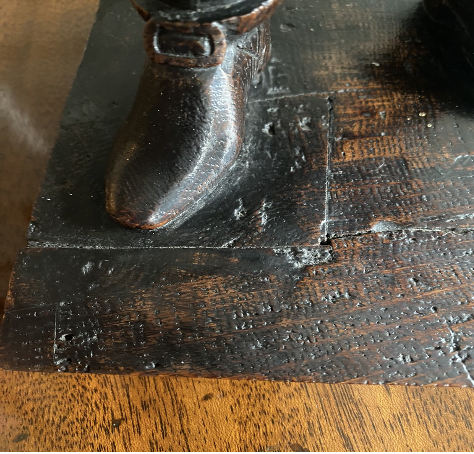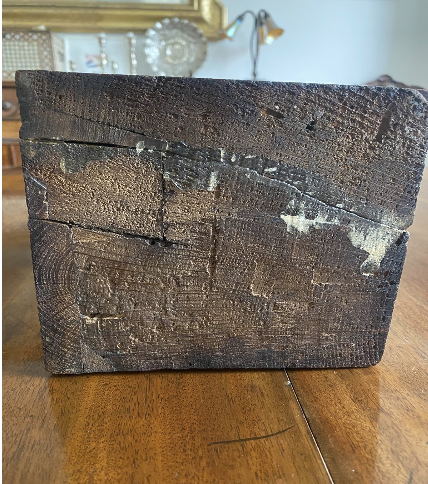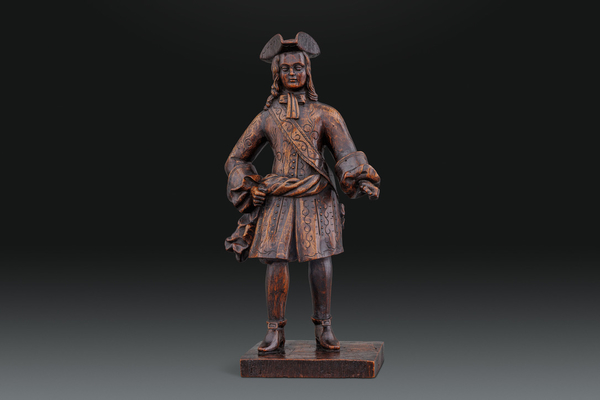Product Description
This fascinating figure is very much in the style of the well-known plaster representations of European merchants created by the Chinese sculptor Amoy Chinqua for export to Europe such as this example in the Metropolitan Museum New York (accession number 2014.569)
https://www.metmuseum.org/art/collection/search/643303ft=amoy&offset=0&rpp=40&pos=1
and there are certainly aspects of our figure that could support an attribution to a similar Colonial workshop producing work for the European market. Our figure is made of multiple pieces of oak spliced together-see for example the way the base is joined underneath the figure’s front foot.
 the join beneath the front foot shown from above
the join beneath the front foot shown from above
 the base of the figure shown from below
the base of the figure shown from below
These splices are definitely not repairs and the patination throughout is totally even, excluding that possibility completely. Unusual construction choices like this are often seen as signs of an Asian export origin as the European oak used to make this figure would have had to have been salvaged and reused as clearly it would not have grown in the Far East. However there are other aspects of the figure that suggest a European origin is more likely.
The costume of the figure is c.1690-1710 and most likely French or Northern European. Perhaps significantly, the sash around the waist of the figure suggests a more elevated figure than a merchant. Although the Chinqua merchant figures are certainly luxuriously clothed, this figure seems to represent someone with even higher social status and attendant wealth. A print in the British Museum showing Louis the Grand Dauphin (1661-1711), the eldest son of King Louis XIV, provides an extremely interesting comparative.
https://www.britishmuseum.org/collection/object/P_1917-1208-3724
The interesting boots on our figure are virtually identical to those worn by the Dauphin in this print, produced some time between 1680 and 1711, and he wears similarly extravagant costume complete with a sash around the waist. In the print the Dauphin has a feathered hat and carries a sword and cane. Despite the pose of our figure, there is absolutely no evidence to suggest that any similar attributes were ever part of composition. There are no marks suggesting missing parts of any sort.
The remarkable condition of this figure naturally leads one to question where it might have been for the past 300+ years. Most surviving oak figures of this date or earlier would seem to have had religious connotations of one sort or another and to have been kept in churches and other places of worship. Secular figures of this sort are much rarer survivals altogether and the scale of this piece makes its original function all the more puzzling. It is too small and too fine to have been conceived as a sort of shop advertising figure and there is no suggestion whatsoever that this is a fragment of a diorama or any sort of architectural fitting as there are no signs of the base having tell-tale holes or marks of the relevant kind. It seems likely therefore that this piece was simply a piece of sculptural carving, intended to be enjoyed in and of itself in a private home.
The Victoria and Albert Museum in London has a carved and gilded wooden statue of the Grand Dauphin on horseback in its collection
demonstrating that such subjects were certainly produced by talented carvers in France in the period when our figure was made. Again there is no evidence whatsoever of traces of paint or gilding on our piece which was clearly designed to have been seen in its natural state.
This intriguing piece is something of an enigma of the best kind. It is an object of great quality that seems likely to be a representation of a real historical figure rather than being an image of a character from a contemporary play or another entirely imagined fictitious flight of fancy. We are delighted to be able to offer this piece to its next owner and it will provide a guaranteed talking point for all those who are lucky enough to see it.












Reviews
There are no reviews yet.